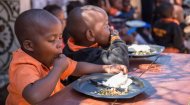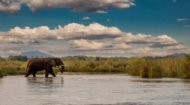|
|
|
Children in Zambia |
Children in Zambia |
Children in Zambia | Children in Zambia |
Bana Tandizo, which means 'helping children', supports some of the poorest children in Zambia
Visit >
Explore
all about the African nation of Zambia in profile articles, pictures, videos
and images.
More >
 |

|
60% of children in Zambia are poor, representing 80.5% of the rural child population compared with a 25.2% of the urban child population. While Zambia still has one of the highest rates of malnutrition and stunting in sub-Saharan Africa, some progress has been made, but 35% of children under the age of five are stunted and 4% of children are acutely malnourished according to the most recent Demographic and Health Survey (DHS) (Central Statistical Office [CSO] [Zambia], Ministry of Health [MOH] [Zambia], and ICF International 2018). The staple diet for children is 'nshima' made from maize flour and, when available, a mush made fom pumpkin leaves. On special occasions this may be supplemented by chicken or fish.
Access to clean water and sanitation remains a challenge for children in Zambia with most low-income families in major towns and cities still reliant on privately-owned boreholes or shallow wells where water is expensive and often contaminated with raw sewage with poor quality water being one of the main causes of infections such as diarrhoea in the country. The situation is compounded by the impact of climate change as water shortages are becoming more common throughout the region of Africa which has one of the fastest growing populations in the world, adding to water scarcity and stress. The spread of AIDS/HIV has also affected life in Zambia with a national HIV prevalence rate of 11.3% among adults ages 15 to 49 as of 2018. Today there are an estimated 1.2 million orphans and vulnerable children living in Zambia, around half of them orphansed by HIV/AIDS.
|









 Children in Zambia attend seven years of primary school, then two and three years at junior secondary and senior secondary school respectively then, for successful candidates, four years at university. Although primary school enrollment and attendance is good, attainment remains low, particularly for those aged between 14-17 years, with 43% of children deprived in this indicator, made worse by the fact that there are areas in Zambia that have no secondary schools. Overall, poor attainmnet is attributed to the low quality and efficiency of the school system in a country where the overall literacy rate stands at 55.3%, though significantly lower for females than males. Unfortunately there is an ongoing issue with a shortage of teachers so many children end their education without a firm grasp of key skills, although the situation has improved following the abolition of tuition fees.
Children in Zambia attend seven years of primary school, then two and three years at junior secondary and senior secondary school respectively then, for successful candidates, four years at university. Although primary school enrollment and attendance is good, attainment remains low, particularly for those aged between 14-17 years, with 43% of children deprived in this indicator, made worse by the fact that there are areas in Zambia that have no secondary schools. Overall, poor attainmnet is attributed to the low quality and efficiency of the school system in a country where the overall literacy rate stands at 55.3%, though significantly lower for females than males. Unfortunately there is an ongoing issue with a shortage of teachers so many children end their education without a firm grasp of key skills, although the situation has improved following the abolition of tuition fees. Children in Zambia, as in so many African countries, are obsessed with football, however poverty means that often the football itself is made from old rags bundled together. Girls also enjoy the game of Nchuba which is somewhat similar to jacks and Isolo, a version of checkers. For those less fortunate, child labour is widespread in the country despite a law that states a child under 13 years of age cannot work under any circumstances with other legislation such as the Child Labour (Prohibition & Regulation) Act of 1986 prohibiting employment of children below the age of 14 years in 18 occupations. Despite this, many children from poor families end up working. A recent study found 28.1% of children in Zambia working, 65.2% attending school whilst of those, 27.6% attended school and were engaged in work such as the producion of cotton, tobacco and other cash crops, raising or herding cattle, fishing, working on boats or curing or smoking fish. Others made money for their families by working in the production of charcoal whisle some were engaged in industry including working in quarries, crashing stones, carrying heavy loads or scavenging mine dump sites whilst girls were more frequently engaged in domestic work and, as ever, much worse. The video (below) gives some insights into the life of children in Zambia together with projects and programs operating there that you may choose to support.
Children in Zambia, as in so many African countries, are obsessed with football, however poverty means that often the football itself is made from old rags bundled together. Girls also enjoy the game of Nchuba which is somewhat similar to jacks and Isolo, a version of checkers. For those less fortunate, child labour is widespread in the country despite a law that states a child under 13 years of age cannot work under any circumstances with other legislation such as the Child Labour (Prohibition & Regulation) Act of 1986 prohibiting employment of children below the age of 14 years in 18 occupations. Despite this, many children from poor families end up working. A recent study found 28.1% of children in Zambia working, 65.2% attending school whilst of those, 27.6% attended school and were engaged in work such as the producion of cotton, tobacco and other cash crops, raising or herding cattle, fishing, working on boats or curing or smoking fish. Others made money for their families by working in the production of charcoal whisle some were engaged in industry including working in quarries, crashing stones, carrying heavy loads or scavenging mine dump sites whilst girls were more frequently engaged in domestic work and, as ever, much worse. The video (below) gives some insights into the life of children in Zambia together with projects and programs operating there that you may choose to support.


